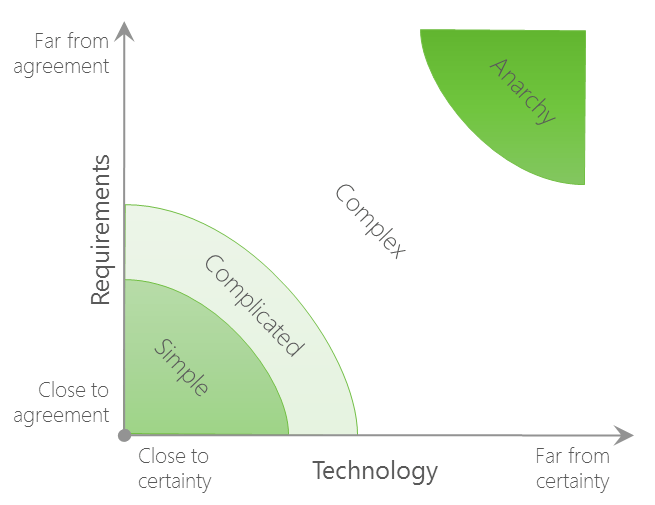Business agility has been highlighted as a key advantage for businesses that have it. They are able to take advantage of new opportunities, pivot to an emerging market or product, or make valuable, customer-centric products. In the digital transformation age, agility is the core mantra for companies transitioning to the digital economy.
But, all is not roses. One of the things I highlighted in an earlier post was the Stacey Matrix here. Many companies have implemented “agile” as a catch-all for their entire business. First, let’s set the record straight: there is no implementing “agile”. You can’t implement an adjective. You can implement scrum, Kanban, XP, or some other agile framework, but don’t call it going agile. It makes you look silly and somewhat illiterate.
There is only One MacGyver; and you are not him
I grew up watching MacGyver (not the reboot). Most of the times he is able to find a way out of a rough predicament by using a combination of creativity and items in his vicinity. He’s most famous for his use of duct tape (although throughout the seven year series, he doesn’t use duct tape that much). He’s spawned a number of cottage industries, including books on how to use duct tape. But I’m getting sidetracked.
The point is, duct tape is a universal tool that can be applied to fix or improve anything. That may be the rule for duct tape, but it isn’t the rule for using agile principles to enhance or improve one’s business. It isn’t a “use in all cases” type of tool. A smart agilist will use agile frameworks and teams in the right cases.
If you are on the senior leadership team, this means that you can’t mandate a top-down transition for everyone, everywhere to follow an agile methodology. You need to understand where to use it.
The Stacey Matrix Explained
Developed by Ralph Stacey, the matrix is a tool to define where problems lie in terms of their complexity. There are four categories of complexity: simple, complicated, complex, and chaos. There are also two scales on which these categories lay: how to solve an issue or what to do to solve an issue. On the how scale, it largely deals with what tools or things (technology) are we going to use to solve the problem. On the what scale, we talk in terms of requirements and mainly refers to the amount of agreement that everyone has about what to do about the problem. Put together, the matrix looks like this:
 Using the Matrix
Using the Matrix
As covered before, agile frameworks are ideal for solving issues that fall within the complex area of the Stacey matrix. So, first you need to plot your issue. Once you understand, or even have an educated guess on where it may fall, then you can begin planning and solving for it.
If you haven’t already, get a giant whiteboard or poster-sized paper and recreate the Stacey Matrix in your company. Then, write down all the issues you have on post-it notes. Once you have the issues written out, place them on the board in order of complexity. It’s okay. . . you don’t need the rest of the post until you have that done. I’ll wait.
Now that you have a handle on where your business issues chart out on the Stacey Matrix, you need agile teams to solve those that fall in the complex zone. In essence you are scaling agile to meet the needs of your business. But, you are scaling strategically rather than a blanket approach. This means that some areas of your business may use a traditional approach (waterfall). That is okay. If the problem is simple, then that approach is the most efficient and works well.
Other Use Cases
The Harvard Business Review has a good article on exactly how different companies are implementing “agile at scale” to solve problems. You can read it here. “Agile at scale” is a little buzz-wordy for my taste, but I’ll allow it since it is Harvard and Jeff Sutherland. Just know that all they are really saying here is that companies are allowing for agile teams to solve their complicated issues.
Just to highlight some examples, USAA went through a transformation and are now comprised of 500 agile teams to solve their complicated business issues. They are expected to add another 100 more agile teams this year. One of the great quotes within the article was from the COO at USAA. He stated, in regards to his agile teams,
“I want to walk into an auditorium and ask, ‘Who owns the member’s change-of-address experience?’ And I want a clear and confident response from a team that owns that experience, whether a member is calling us, logging into our website on a laptop, or using our mobile app. No finger-pointing. No answers that begin with ‘It’s complicated.’”
What is great about that is that USAA took the time to map out their issues. Then, they took the leap to create agile teams dedicated to solving the problem. I find it amazing that not only did they know the complexity of their issues, but they also knew how many teams they needed to address their issues. How many business leaders can say that for their companies?
Another highlight of the article, since I love aviation, is how Saab is using over 100 agile teams to develop their $43 million fighter jet. Agile teams are small, but they can solve larger-than-life issues if you let them.
Conclusion
Now, even though you have a better understanding of when to implement an agile approach to problem solving, you are missing one last step. You need to have your entire organization trained in agile principles. Yes, the entire organization including the people that will not be working on an agile team. The reason for this, as outlined by Darrell K. Rigby, Jeff Sutherland, and Any Noble in the HBR article, is that there will be natural impediments that people will have when needing to work with an agile team. The training is meant to help the non-agile teams understand how to interface with the agile team when needed. Without that training, they might as well be speaking two languages. Your list of accomplishments will quickly dissipate without the context needed across the entire organization.
If you need help in teaching your team about agile principles, I can help with that. I’ll be co-facilitated an interactive workshop where we go over 8 principles of an agile mindset. This is the context that any company contemplating an agile transformation needs to go through. You can learn more or sign up with the button below.
I'm Doing an Agile Mindset Workshop Read More!
Thanks for reading!
Being > Doing
db





